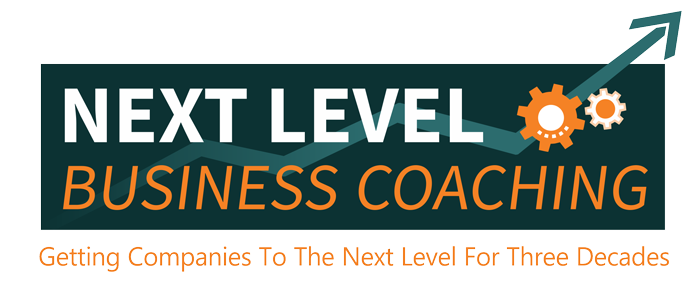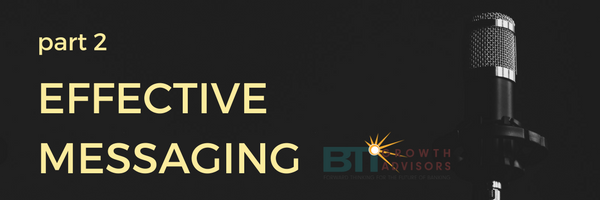By Ray Adler, CEO BTI Growth Advisors, Inc. This blog shines a light not just on the inefficiencies in your bank’s sales efforts but also why banks are having such difficulties evolving with the times. To better understand the difficulty banks are experiencing in their efforts to evolve and improve performance, we don’t need to […]
What separates the top 10% of sales personnel from the bottom 90%?
They are diligent about how they spend their time.
In banking, and likely many other fields, there is always something to do to take care of your customer. When you place your focus on always serving, the marketing function doesn’t happen. And when you stop marketing, your pipeline flatlines! I don’t know about you, but I hate waking up a 3 a.m., staring at the ceiling, wondering where my next deal is coming from. Read more
Banking landscapes for the last twenty-five years have been extremely favorable for the industry. The economy has been strong and vital. The stock market has reached highs never experienced before, and interest rates have been at historical lows.
It’s safe to say that the financial services industry has benefited from a tailwind. We’ve enjoyed a good run.
And yet… Read more
Three Reasons to Build a Successful Touch Program
Have you ever called a prospect whom you met with 10 or 12 months prior only to discover that they already changed banks? Scratching your head, you remember the connection you had with that prospect. You wonder “why didn’t they call me, we had such a great meeting?” The truth is you were forgotten. And the reason you were forgotten and you missed a perfect sales opportunity is you lacked a disciplined follow-up process. One that enabled you to add value and would keep your name top of mind for the prospect until they were ready to switch banks.
Because it’s hard to know when the “buying window” will open and a prospect is considering switching banks, we need a process to help ensure we stop missing sales opportunities… Constructing a disciplined process for maintaining contact with prospects will minimize the very real risk of being forgotten. In your touch program, you must build a disciplined process for:
- Build trust and name recognition. This can be achieved through repetitive “touches” or communications. We recommend you alternate between email, phone call and maybe a handwritten note. Mix it up a little. Consistency is key.
- Add value. Adding value by being a facilitator of introductions as well as that of a consultant or advisor positions yourself uniquely in the marketplace while providing a wealth of contacts, and subsequently, value for your customer. We recommend you send a monthly email with an article attached for two consecutive months, then on the third month make a phone call to the prospect and invite them to a breakfast or lunch meeting. Repeat this process every quarter.
- Establish yourself as an Expert: Finding and sharing quality business content is fast and easy, plus it makes you look more knowledgeable. Keep in mind, the article doesn’t have to be the “perfect”; just by sharing the knowledge you get credit.
Residential Realtors are some of the best at developing “touch programs” for consistent exposure. Realtors systematically leave reminders: a door hanger, a flyer on the front door, a flag with their business card on 4th of July. They’re disciplined with their communications (“touches”) because they never know when “the buying window” as a result of some event occurring and a homeowner is now ready to sell their home.
Stop missing sales opportunities due to disorganization, lack of discipline and not having a process. A touch program can be built in a couple hours time which isn’t much when weighed against the time required to create a quality sales appointment.
In November’s edition of The Evolutionary Banker, I addressed a few trends that are changing the ways in which business owners and corporate decision-makers are making buy decisions. It’s imperative we understand these trends so we can adapt accordingly. One of the takeaways from November’s blog was that decision-makers are looking for their vendors and service providers to have more knowledge and expertise in their industry and with their types of businesses. The value proposition of today’s “generalist” salesperson continues to decline. The same holds true for the generalist relationship manager. Having a little knowledge about a lot of industries practically ensures you’ll position yourself as a commodity in the market.
In this edition of The Evolutionary Banker, I’ll walk you through the process of evaluating your professional and personal background in a way that will help you to better leverage your collective body of knowledge and professional expertise such that it will help you to focus your 2018 business development activities.
The process I will lay out for you is exactly the process I went through personally in 1999 when I transitioned from being a generalist business trainer, coach, consultant to one who developed deep industry expertise such that I am a sales culture expert for banks.
Now the value of “positioning” yourself and your bank as having industry expertise applies regardless whether your bank is in a rural market or a metropolitan market. However, what does differ is the execution of the strategy.
In rural markets, we coach relationship managers to tailor their presentation so that they highlight their years of experience and expertise with businesses similar to the business they’re calling on. As you meet with business owners in different types of businesses, your story has to change in order to highlight your expertise working with businesses similar to the one you’re calling on. That’s what “positioning” means — to consciously and ethically shape perceptions.
A quick but related side note, too many bankers call on businesses in different industries and say the very same things and represent their bank in identical ways. I call that “pin-the-tail-on-the-donkey” positioning. The relationship manager is hoping to hit the bulls-eye and say something that he or she hopes will resonate as unique with the prospect. Given that 3 out of 4 bankers present themselves in an identical way, the approach used by most RMs has the opposite effect of achieving differentiation — it positions them as a commodity.
Back to the discussion of execution… in metropolitan markets, we’re seeing more and more relationship managers focus their outbound business development activities on one or two niches/segments as a means of boosting their productivity.
Our goal of my three recommendations below is to help you establish your market “sweet-spot.” Your sweet-spot is defined as that segment of the market where your talents, expertise, experience, track-record, and contacts are highly desirable and highly valued. Aligning all of these “assets” will make your business development activities far more productive in 2018. The following are the steps and evaluation process necessary to determine your sweet-spot:
#1. Realize you’ve already developed industry-specific knowledge: As a result of being a relationship manager for ten or twenty years or more, you have naturally developed deeper pockets of industry-specific knowledge based on the business you’ve conducted in the past.
Questions to help you assess your existing expertise include:
- Are there certain industries where you’re naturally more comfortable talking to those types of business owners and decision makers?
- Are there industries where you have a deeper knowledge of the industry, and a greater grasp of industry jargon and acronyms?
- In what two or three industries have you done more business than other industries?
- What industry concentrations exist in your existing portfolio?
These may represent industries that would be fruitful to focus on in 2018. But more analysis and reflection are required.
#2. Evaluate your upbringing: Without even realizing it, we may have been exposed to and learned about certain businesses either through our parents or the various jobs you may have held growing up. For example, if one of your parents was a doctor, likely you were exposed to numerous discussions throughout your childhood related to the medical field and being a doctor. If your market has a fair number of medical groups and hospitals, your upbringing will be very useful when calling on doctors, medical groups, and hospitals. If your parents owned an auto-parts business, likely you learned a lot about the automotive industry growing up. If your bank has banked companies in the automotive industry, the knowledge and stories you were exposed to growing up will be extremely useful when calling on automotive-related businesses in 2018.
Questions to help you assess your upbringing include:
- What profession were/are your parents in?
- What professions interested you growing up?
- What were or are your hobbies?
These questions can help you assess whether or not any knowledge gained while growing up may be of use and leverage as you strive to determine your sweet-spot for 2018.
#3. In which industries do you have the most contacts? We say frequently in the Sales Honing Academy, “like fish, business people swim in schools.” We recommend assessing your database of contacts to determine where you have concentrations of contacts in the same industry. These concentrations of contacts represent an excellent and completely overlooked source of referrals and warm introductions. I recommend organizing all of your contacts by industry type. For example, group all of the doctors you know together, likewise list all of the contractors you know in another list. Keep working your way through your database until you get everyone (customers, colleagues, vendors, salespeople, friends and even family members) segmented by industry type.
Currently, your contacts are likely listed in alphabetical order. This makes them easy to find, but not easy to leverage. That’s a huge distinction. When you take the time to classify your contacts by industry type, your marketing productivity and the value you’re able to provide others will skyrocket.
The question you want to ask yourself when assessing your database is: In which two or three industries do I have the most industry contacts?
To summarize:
The world is changing. What we did in the past to be successful, likely isn’t going to sustain our success in the future. Knowing this, we need to start the process of changing the ways in which we market and sell the services offered by our bank. Your prospects and customers are looking for more knowledge, advice, and counsel from their vendors and service providers. Let’s make sure we adapt to the times! The recommendations above will move you a long way towards leveraging your experience, expertise, and your contacts.
The entire world is changing, so too is the world of sales. Astute bank leaders and relationship managers decipher these signs and adapt. Remember, extinction is what occurs when a species is unable to adapt to environmental changes. Many banks will face extinction over the next five years, but those that adapt will continue to thrive in this new era of selling.
The following are three trends that are affecting how we will develop new business:
- Direct access to decision-makers will diminish.
If your relationship managers are having trouble getting in front of decision makers now, beware, it’s only going to get tougher. A lot tougher. CEOs and business owners alike are buried in assessing and trying stay ahead of all of the changes driven by technology, regulation, consolidation, and innovation. This means there will be less interest and time available for face-to-face meetings with bankers. - Standardizing of the buying process.
Buyers will continue to leverage technology in every area of business to drive up efficiency and drive down costs. Gartner estimates that by 2020, customers will manage 85% of their purchase transactions without talking to a human. Going directly to the source and by-passing the traditional sales process and sales people all together is already being seeing in manufacturing, distribution and dealers. It’s only a matter of time till we’ll see it in banking. - Decision-Makers are demanding more.
The old needs-based selling model developed by IBM and Xerox is not entirely dead. But it’s close. The consultative sales model still offers a competitive advantage in slower evolving industries such as banking. But a new era of selling is emerging which calls for salespeople to have more expertise and industry specific knowledge. As markets become more crowded and business in general becomes more complex, business owners and corporate decision- makers are looking for more insights, recommendations and strategic advice from their vendors and partners. Your relationship managers must learn how to deliver value outside of the standard promises made by every banker of responsiveness, service and pricing. The new style of selling is called “authoritative selling.” Authority selling is the approach that will help you stand head and shoulders above your competitors in a side-by-side comparison. Authorities have more than a surface level understanding of an industry. They have deep insight that becomes readily available to a prospect when relationship managers use industry specific terms and are able to refer to specific equipment used by their prospect by name. Authorities understand the industries pain points, not just the pain points of a specific company and that is a true competitive advantage. Relationship managers will be called on to bring more to the table if they hope to retain their long-time clients and remain successful in the future.
Simple Steps to Becoming an Authority and Expert
Relationship managers are typically fearful of seeing and defining themselves as authorities and experts in anything other than banking. Part of what it means to evolve means being open to redefining ourselves and our value proposition. The following are some simple steps you can take to better position yourself as more of an authority and expert.
- Leverage your existing experience: Review your entire banking career; are there a couple industries where you’ve had more clients than other industries? Are there a couple industries where you’ve done significantly more transactions than other industries? Not that this is the sole criteria for choosing to focus a percentage of your business development time on one or two industries, but it is a consideration.
- Consider the depth of the market: In rural markets, relationship managers don’t have the luxury of focusing on a particular industry. That said, for community banks in rural markets, your relationship managers still need to demonstrate industry specific knowledge and present themselves and their bank as having deep expertise in that industry. In metropolitan markets, relationship managers need to research and assess the size of various vertical niches in which they’re considering pursuing. Is the niche large enough with enough companies and businesses that match well with your banks credit appetite and product offering? As an example, in Los Angeles and Orange Counties, there are 4,228 “professional services” firms with revenues of $3M to $50M. That niche is more than large enough to focus some of your business development activities on becoming an expert at and known for working with professional services firms.
- Leverage Online Platforms: Conducting industry research has gotten very easy. Googleand other search engines represent very powerful ways to search the internet for industry specific resources. In working with hundreds of relationship managers in rural and metropolitan markets helping them to implement a segmentation approach, we have found tons of useful resources that are free. Of course there are the “tried and true” resources such as D&B and advanced data platforms from Vertical IQ, Nielsen and Resonate.
The value proposition of today’s “generalist” banker is declining. Decision makers are expecting more insights and recommendations from their relationship managers that can positively impact the business. Simply providing a commercial loan or line of credit isn’t likely to sustain banks in the near future. Developing industry expertise that helps you differentiate yourself is crucial for on-going success.
The 2018 Sales Honing Academy is a great way for Relationship Managers to move away from generalists and start building value and relationships with prospects. We’re offering two programs in 2018 allowing you to pick the best option for your team. Learn more.
![]()
In this final blog in my three-part blog series on effective customer messaging strategies, I’m going to focus in on five steps you can do to tailor your message so that it resonates with each prospect and customer. Our goal is to create as much affinity as possible with each and every prospect with which we meet. As you may recall from Part Two of this blog series, affinity is a natural attraction that is formed between two parties due to their similarities. Also discussed in Part Two was narrow-casting which is the art of tailoring your message to your audience. By narrow-casting the messages we deliver to our prospects, we create affinity.
Differentiating ourselves from our competitors is one of the toughest things to do today, especially for banks as most offer nearly identical products and services. Narrow-casting is a powerful strategy that helps guard against sounding and selling like every other banker by developing a unique ability to communicate with customers in ways that resonate with each one.
Here are five steps you can take to make sure your communication strategy is honed for every sales call you go on be it with a prospect or an existing customer.
 #1. Thoroughly read your prospect’s website – As you likely know, a company’s website is a carefully crafted expression of that company’s philosophy, values and service offerings. It’s like their company “fingerprint” in that it is extremely personal to them. A quality sales call deserves careful pre-call preparation which includes reading your prospect’s website. Don’t skim your prospect’s website! Read it! Ideally, you want to demonstrate deep industry and company knowledge in your sales call as a means of differentiating yourself from your competitors. The foundation of being able to do that is truly reading the prospect’s website.
#1. Thoroughly read your prospect’s website – As you likely know, a company’s website is a carefully crafted expression of that company’s philosophy, values and service offerings. It’s like their company “fingerprint” in that it is extremely personal to them. A quality sales call deserves careful pre-call preparation which includes reading your prospect’s website. Don’t skim your prospect’s website! Read it! Ideally, you want to demonstrate deep industry and company knowledge in your sales call as a means of differentiating yourself from your competitors. The foundation of being able to do that is truly reading the prospect’s website.
 #2. Learn your prospect’s positioning strategy – The development of a company website is usually quite a lengthy process. The layout of the pages, the images selected and the copy are all carefully crafted to make the right impression to their prospective customer. If you skim your prospect’s website, you will miss a lot of important information that will help you craft a communication strategy that will position you and your bank as the ideal choice. Notice the images used throughout the website. Do these images show an organization that is stable and traditional? Maybe the images show an organization that is innovative and progressive. Remember the old adage “a picture is worth a 1,000 words?” The images used on your prospect’s website starts the process of honing your communication strategy.
#2. Learn your prospect’s positioning strategy – The development of a company website is usually quite a lengthy process. The layout of the pages, the images selected and the copy are all carefully crafted to make the right impression to their prospective customer. If you skim your prospect’s website, you will miss a lot of important information that will help you craft a communication strategy that will position you and your bank as the ideal choice. Notice the images used throughout the website. Do these images show an organization that is stable and traditional? Maybe the images show an organization that is innovative and progressive. Remember the old adage “a picture is worth a 1,000 words?” The images used on your prospect’s website starts the process of honing your communication strategy.
 #3. Their positioning strategy becomes your positioning strategy – The copy used throughout your prospect’s website may have been written by a professional copywriter or possibly an internal marketing person. Regardless of who wrote the website copy, rest assured that a lot of people read, edited and honed that copy before it went live on their website. Notice the words and phrases used throughout the website. Likely you’ll see certain words and phrases used consistently throughout the website. When you find those words and phrases, you’ve hit pay dirt because those words and phrases give you the clues you need to really dial in how you position your bank and its products and services.
#3. Their positioning strategy becomes your positioning strategy – The copy used throughout your prospect’s website may have been written by a professional copywriter or possibly an internal marketing person. Regardless of who wrote the website copy, rest assured that a lot of people read, edited and honed that copy before it went live on their website. Notice the words and phrases used throughout the website. Likely you’ll see certain words and phrases used consistently throughout the website. When you find those words and phrases, you’ve hit pay dirt because those words and phrases give you the clues you need to really dial in how you position your bank and its products and services.
 #4. Their words become your words – When a company makes references about the history of the company, the values and philosophies that they adhere to or commit to while delivering quality products and services with the utmost of integrity…THOSE are the exact words you want to use when describing your bank.
#4. Their words become your words – When a company makes references about the history of the company, the values and philosophies that they adhere to or commit to while delivering quality products and services with the utmost of integrity…THOSE are the exact words you want to use when describing your bank.
Real World Example:
The following words and phrases are taken verbatim from the “About” section of a very successful company’s website:
“Service has been the cornerstone of our historic growth and successful operation for the past fifty years.”
We pride ourselves on:
- Partnership reputation
- Understanding our customer’s culture
- 24/7/365 availability
- Ability to adapt and grow with our customer’s business trends
We have grown steadily during this time by following our motto… “exceeding expectations…together!” This philosophy represents not only our internal teams working together, but our associates working with customers to find creative and unique business solutions that will provide a more efficient and cost effective business model.”
The Key:
These words were carefully developed to tell a story that differentiates their company to their customers. Again, they are like corporate “fingerprints.” The words on your prospect’s website provide you with a clear customer messaging strategy. They tell you what’s important to them! Let your competitors describe their bank in generic terms over and over again. You now have a highly effective strategy to describe your bank in unique terms that will create affinity and that resonate with every prospect!
There is a very simple communication format for weaving those phrases called positioning statements into your conversations. Again, the goal of this strategy is to position your bank to be very similar in many ways to your prospect’s business.
How To Do It: Your positioning statement gets linked to a statement about your bank, product, service, culture, values and philosophies.
Your positioning statement: “Today, service really needs to be the driver of company growth and successful operation.
Statement about your bank: “Since the beginning, the founders have worked hard to instill a partnership mindset and culture in the bank. We strive to be available to our customers on a 24/7/365 basis which allows us to grow and adapt with our customers business trends.”
Expressed this way, this statement would create affinity and resonance with the owner of a company that espouses these virtues. It would also differentiate you powerfully from any other bankers the owner may be considering doing business with. You would be positioned as the ideal choice! That’s how powerful this strategy is.
 #5. Integrity above all
#5. Integrity above all
The final point is the most important strategy of the bunch. With very little creativity and a high degree of integrity, it’s pretty easy to utilize a large percentage of positioning statements found on the website of your prospects when describing your bank and its products and services. However, the representations we make about our banks must be accurate.
If you work for an extremely conservative bank and you’re calling on a company that prides itself on being innovative and progressive, then it would be completely out of integrity to represent your bank as innovative and progressive.
In conclusion – In any highly commoditized industry, it is imperative sales people are able to utilize advanced customer messaging strategies to create affinity with prospects and successfully differentiate your bank from the six others that are competing for the business. Effective customer messaging takes time to develop. But if you’re calling on high quality prospects, why wouldn’t you take the time to give yourself a competitive advantage.
Welcome to the second blog in a three-part series dedicated to the art and science of effective customer messaging. As we discussed in my last blog, the common banking jargon and buzzwords used by most Lenders and Relationship Managers, position them as a commodity. Sometimes good customer service, competitive rates, and broad selection of financial products are not enough to differentiate a bank from their competitors in today’s highly competitive business landscape.
 In this blog, I’ll be discussing the role of the following aspects that lead to more effective customer messaging:
In this blog, I’ll be discussing the role of the following aspects that lead to more effective customer messaging:
- Affinity – A powerful force used to differentiate and attract new customers
- Narrow-casting – The art of tailoring your message to your audience
- Thinking differently about what a company website represents
Well-Known Brands with Effective Customer Messaging Strategies
In my last blog, I referenced the following five companies who are exceptional at branding and messaging customers.
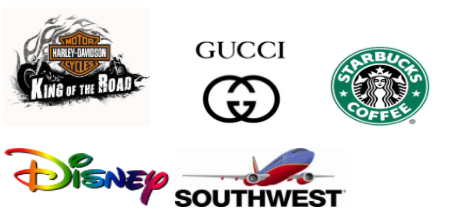
As we delve deeper into the subject of customer messaging, let’s briefly look at these five companies and their customer messaging strategies.
Two factors strongly contribute the effectiveness of their customer messaging strategy.
1. They know who is their ideal customer
In today’s saturated market, generalized, “one-size-fits-all” messaging that is designed for a broad audience simply is not heard. It’s just more noise in an already noisy marketplace. Effective marketers target very specific types of customers — ones they know from their experience are the “ideal customers.”
They do this for two reasons:
- They don’t have the budget sufficient to effectively mass-market
- Capturing the attention of new customers isn’t easy
2. Their marketing messages are crafted to resonate with their ideal customer
 This is called “narrow-casting” which is a fancy word for focusing your marketing messages such that they resonate with your ideal customer. Just like a dog-whistle can only be heard by a dog, to create effective marketing messages, they must be designed and crafted to speak directly to the hearts and minds of a company’s ideal (most profitable and loyal) customer. When done effectively, a marketing message creates an affinity or attraction between a company and their ideal customer. That attraction causes a customer (new or prospective) to be interested in what a company is offering.
This is called “narrow-casting” which is a fancy word for focusing your marketing messages such that they resonate with your ideal customer. Just like a dog-whistle can only be heard by a dog, to create effective marketing messages, they must be designed and crafted to speak directly to the hearts and minds of a company’s ideal (most profitable and loyal) customer. When done effectively, a marketing message creates an affinity or attraction between a company and their ideal customer. That attraction causes a customer (new or prospective) to be interested in what a company is offering.
Who are the ideal customers for the five companies identified above and what is their customer messaging strategy?
- Harley Davidson’s ideal customers are men ages 35 to 65 who are either somewhat rebellious by nature or who want to break from convention and take to the freedom of the open road.
- Gucci’s ideal customers are mostly wealthy or upper-middle class women primarily, but also men. When you wear Gucci, you tell the world you’re sophisticated, successful and that “you’ve arrived.”
- Starbucks ideal customers are hipsters of every age. Starbuck’s is an experience and their locations have become extensions of our living rooms where people hangout for hours and offices where people meet to discuss business.
- Disney’s ideal customers are kids who want to go to the “happiest place on earth.” Disney’s brand speaks to all parent’s desire to create lasting family memories.
- Southwest Airlines is “the fun airline” whose ideal customers are friendly, fun and like low fares.
What do you notice about all five of these well-known brands? Their messaging is carefully designed to speak and resonate with their ideal customers. These companies craft marketing messages that create affinity between the company and their ideal customers.
 What Is Affinity?
What Is Affinity?
Advertisers have been using affinity to attract their ideal customers for centuries!
Affinity – Noun
- an attractive force
- a natural liking for or attraction to a person, thing, or idea
- a person, thing or idea for which such a natural attraction is felt.
When Lisa and I work with Relationship Managers and Lenders on improving their customer messaging, we guide them through an evaluation process that helps begin to define their target market and their ideal customer. If you’re going to improve how you message customers, you must abandon the notion that saying the same things you’ve always said to different customers is effective. It’s marginally effective at best. You want to communicate in a way that creates affinity between you and your prospective customer.
There are many benefits to creating affinity with your ideal customer. It helps you and your team:
- Focus your marketing efforts and make you more efficient
- Leverage your strengths
- Become more effective at differentiating yourself from your competitors
- Bring more value to your customers by better leveraging your knowledge, expertise and experience
- Become better able to put yourself in situations where you’re most attractive to your ideal prospect
If your desire is to work smarter, not harder, you must become more strategic and disciplined about your marketing efforts.
Thinking Differently About Company Websites
Lisa and I are huge believers in having a disciplined and in-depth, pre-call planning process. If you’re preparing for an in-person sales call with a potential ideal customer, why wouldn’t you thoroughly prepare? After all, ideal customers are your bank’s most profitable and loyal customers.
Unfortunately, the pre-call planning process of the majority of Relationship Managers is anything but disciplined, and it certainly isn’t “in-depth.” All too often, pre-call planning happens in the car while driving to the sales call.
Part of a thorough pre-call planning process involves reading (not skimming) and studying, (you heard me right) “studying” a company’s website.
A company’s website is far more than just a presentation of facts, history, products and services offered by a company.
A Website Is Like a Fingerprint
Everything on a company’s website is designed with a purpose and every sentence and paragraph is carefully crafted. So much time and energy goes into the development of a website because it is usually the hub of a company’s marketing platform. It is an individual and unique expression of a company much like a fingerprint is unique to each individual.
Consider what else beyond the surface level information you can glean from a company’s website:
- What the owner’s values are and what the company values
- What it takes to build a successful company
- The vision and mission of the company
- What differentiates them from their competitors
- What is their philosophy on customer service
- What they are committed to
- Are they a charitable company and if so, what charities do they support
- How they present and position their products and services to their prospective customers
This information is the critical content every Relationship Manager and Lender should be using to craft much more effective marketing messages.
In my final blog post on this subject, I’ll be focusing on the development of a true customer messaging strategy that is unique and specific to each of your team’s sales calls.
The following is part one of three for a series of posts that will help you develop a clear and unique “message strategy” for every sales call. By utilizing the following tools and prompts, your sales calls will make a stronger connection with your customer and therefore be more effective.
The messaging and positioning strategies I’ll be discussing are very advanced sales strategies. Few commercial lenders even know about them, let alone know how to utilize them. They are without a doubt incredibly useful in helping you differentiate yourself from your competitors. The reality is advertisers have been using these highly effective messaging and positioning techniques and strategies for decades to sell billions of dollars’ worth of products and services.
Why it is important to have a strong message.
Approximately a decade ago, I was in Line A (remember Southwest’s old boarding system?). I was chatting with a very smartly dressed business woman. We discussed business and when I told her of my new client, she replied, “Interesting. I had a couple of their lenders come out and meet with me a few months back. Then again, I’ve been contacted by at the lenders from five different banks in the last six months.”
Intrigued, I asked her, “So, what was your experience meeting with these lenders?” To which she replied, “The experience was completely typical and unmemorable.” Then she added, “Don’t get me wrong, they were nice, knowledgeable friendly bankers.”
OUCH! “Completely typical and unmemorable.” Sometimes the truth hurts. It is common for most sales people in any industry to make similar claims and statements when speaking to customers, but all the more reason for you to develop a strong message that will break through this monotony and make yourself memorable.
 Messaging Rule #1: Differentiation Occurs By Behaving and Communicating Differently
Messaging Rule #1: Differentiation Occurs By Behaving and Communicating Differently
Most every banker touts their bank’s customer service, responsiveness, and competitive rates as differentiators. The problem is, so does every other banker, which only further commoditizes an already commoditized industry. The first step you can take in the journey of learning how to message customers effectively is to become aware of the fact that much of what you’re saying to customers at the present time isn’t helping you differentiate yourself…it is actually hurting you!
We have some bank clients who developed almost story-like presentations about their bank. These stories include statements such as “we’re family owned” or “we’ve been around for over 100 years” and the assumption is that these statements matter or are meaningful to the customer. Notice I said the assumption is that the message is meaningful to or resonates with the recipient. Now, if you’re calling on the owner of a family run business, stating that your bank is family-owned will very likely “resonate” with the prospect and position you favorably. Likewise, if you’re calling on a company that has been in existence for over 100 years, stating your bank has been in existence for over 100 years will likely also position your favorably. In these scenarios, the “messaging strategies” will likely be on point. But to use that message with any other prospect other than the owner of a family run business or a 100 year old company, the message will likely have no value because it doesn’t resonate. Said another way, the statement is just more noise in an already noisy market! It’s the wrong messaging strategy for THAT prospect. The lender’s positioning strategy was not aligned with the recipient of the message.
Since we’re not selling to robots, why would we think that by making the same claims and representations over and over and over to individuals would be an effective way to position ourselves as unique? Why would we wing-it and make all sorts of assumptions about what will resonate to a prospect? Lisa and I call this “pin-the-tail-on-the-donkey” customer messaging for obvious reasons. Are you ready to take the blindfold off?
 Messaging Rule #2: You Never Get A Second Chance To Make A First Impression
Messaging Rule #2: You Never Get A Second Chance To Make A First Impression
Messaging customers effectively is both an art and a science. It’s crucial to do it effectively, especially on an initial prospect call (your first in-person sales call) because it only takes a few minutes before a prospect forms an impression about you and your bank. We’ve all heard the adage, “you never get a second chance to form a first impression.” This couldn’t be more true than on an initial sales call.
To learn how to message customers effectively, we first must learn, understand and begin to utilize certain terminology:
Positioning – “Positioning” is a term and powerful strategy born out of the advertising industry. The definition and intent behind positioning is:
- To make a positive and distinctive first impression based upon saying or doing things differently from how your competitors communicate or behave on an initial prospect call.
- A marketing and communication strategy that aims to make a brand occupy a distinct position in a market, and in the mind of the customer relative to competing brands.
- How you differentiate your product or service from that of your competitors and then determine which market niche to fill. Positioning helps establish your product’s or service’s identity within the eyes of the customer.
- Positioning defines where your product or service stands in relation to others offering similar products and services in the marketplace.
Good positioning makes a product unique, forms an emotional connection with the customer literally within 30 seconds to a couple minutes of first contact with the prospect. Good positioning also makes prospective customers strongly consider doing business with your company as a distinct benefit to them. In a cluttered and noisy marketplace with lots of products and brands offering similar benefits, effective positioning:
- Makes a brand or product stand out from the competition
- Helps a company command higher pricing
- Creates an emotional bond between a company and its customers
- Creates affinity or attraction which helps draw customers to a particular company
- Allows a product and its company to ride out bad times more easily
Well-known brands with effective customer messaging strategies:

As it relates to messaging customers, it is critical to understand that a company’s positioning strategy is to design messages that will resonate and be interesting to a specific demographic of the market. Said another way, a company’s messages are designed to attract the attention of the company’s ideal customer.
Action Item:
In preparation for my next blog, I want you to consider the following questions:
- Who are the ideal customers for the five companies identified above and what is their customer messaging strategy?
- What is the intent of your current messaging strategy?
- Who is your ideal customer?
- Do you find yourself describing the bank in nearly identical ways to different people?
- Look at your bank’s website. What message are customers receiving and is it distinctive? (Look at your competitors’ sites to find out.)
For part 2 of our Effective Message Development series, we will address:
- How to create affinity (an attractive force) that causes customers to want to do business with you
- How to do research prior to a sales call that helps you design a customer messaging strategy
- How to develop a customer messaging strategy that is unique for every sales call
![]()
Ray Adler
CEO & President
BTI Growth Advisors, Inc.
760-720-9270
BtiGrowthAdvisors.com
SalesHoningAcademy.com
Your Car Isn’t Thirty Years Old, Why Are Your Lenders Utilizing Marketing Strategies That Are?
 It’s probably a safe bet that the car you’re currently driving wasn’t made in 1987. In the past 30 years, cars have improved a lot. Fuel efficiency, emission reduction, technological advancements and safety features have improved dramatically.
It’s probably a safe bet that the car you’re currently driving wasn’t made in 1987. In the past 30 years, cars have improved a lot. Fuel efficiency, emission reduction, technological advancements and safety features have improved dramatically.
However, when it comes to how lenders market and sell bank products and services, there has been little if any change over the past thirty years. Let’s examine various trends that support the need for banks and lenders to evolve their thinking and strategies as it relates to marketing.
#1. Technology Continues to Devalue the Role of the Sales Person
It’s like this in every highly commoditized industry. Customers have grown very comfortable doing their own product and company research and making their own buying decision without the need for interacting with a sales person. Cars, appliances, furniture, insurance policies and thousands of other commodity products can be purchased from the convenience of our homes. And with services like Amazon Prime, your purchases arrive often within 18 to 24 hours. The cold hard fact is that the internet, massive advancements in data mining, credit scoring and loan processing technologies continues to devalue the role of sales people. Simply said, lenders like branches are becoming obsolete.
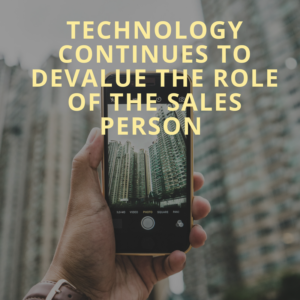 Now, we’re not saying that there won’t be a role for lenders in the future of banking. But we are saying that if steps aren’t taken adjust to this trend, customers will continue to favor pricing as the primary differentiator when all other factors are similar. Part of the solution to combat this trend is to take steps to increase the value your lenders are able to deliver to customers by increasing their knowledge and expertise. Lenders must become more knowledgeable on a much broader array of subjects beyond lending. Developing niche industry expertise is one powerful way to raise the value you’re able to provide your customers as well as improve their ability to differentiate themselves from your competitors.
Now, we’re not saying that there won’t be a role for lenders in the future of banking. But we are saying that if steps aren’t taken adjust to this trend, customers will continue to favor pricing as the primary differentiator when all other factors are similar. Part of the solution to combat this trend is to take steps to increase the value your lenders are able to deliver to customers by increasing their knowledge and expertise. Lenders must become more knowledgeable on a much broader array of subjects beyond lending. Developing niche industry expertise is one powerful way to raise the value you’re able to provide your customers as well as improve their ability to differentiate themselves from your competitors.
#2. Your Competitors Are No Longer Just Banks
Online lending platforms are growing rapidly and gobbling market share at a feverish clip. Your competitors are no longer the other 15 to 20 banks in your market. Recent research documents that C&I lending tanked from a 9.0% annual rate in Q2 of 2016 to only 3.5% in Q3. While the pending election likely played a factor is that decrease, the fact remains that nonbank lending sources are capturing your market share at an alarming rate. These online lending platforms are growing in their sophistication as well as increasing the loan size they’re able to facilitate.
 To provide a bit more context to this issue, eCommerce has been steadily growing over the past five years. Total transaction volume hit $327 billion in 2016, up from $202 billion in 2011. More brick-and-mortar-focused retailers are stepping up their online game and increasing the percentage of their sales that come from online channels, and Web-only retailers have been growing at an impressive clip, too. Retailers have spent these years honing the shopping experience on their websites. But just when they thought they knew their consumers, things are changing again.
To provide a bit more context to this issue, eCommerce has been steadily growing over the past five years. Total transaction volume hit $327 billion in 2016, up from $202 billion in 2011. More brick-and-mortar-focused retailers are stepping up their online game and increasing the percentage of their sales that come from online channels, and Web-only retailers have been growing at an impressive clip, too. Retailers have spent these years honing the shopping experience on their websites. But just when they thought they knew their consumers, things are changing again.
One of the biggest impediments to changing and evolving with the times is the herd mentality or “group think” that exists in companies. As an industry we must place a high value on and encourage divergent and disruptive ideas. Senior executives who have been in banking thirty and forty years must tap into the insights that younger bank employees have to offer. When was the last time your bank conducted an employee engagement survey or any type of survey? It’s short-sighted to believe that financial performance means your bank is running smoothly. Employees are an incredible untapped resource that can help your bank evolve and improve in order to stay relevant and competitive. The ability to embrace change is giving certain banks a true competitive advantage. The inability to change or to be in denial about the need to change is becoming more and more risky.
#3 Not Changing Is Riskier Than Changing
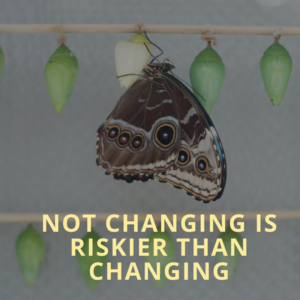 The rise of social media is shaking up things in surprising ways across the board. The emergence of mobile as a major shopping channel is putting new power into consumers’ hands. Customers expect to use all channels as though they are a single experience, requiring tight integration across those channels. And big data now makes it possible to gain deeper insight into consumers more than has ever before. Other industries such as airlines, hospitality and retailers have been utilizing big data to drive tailored product and service offerings and revenues for over twenty years. With few exceptions, the banking industry has only recently (within the last five years) started venturing into the world of big data and data mining. Regional, business and community banks must explore these new technologies as they represent significant cost and time savings which translates into faster response times.
The rise of social media is shaking up things in surprising ways across the board. The emergence of mobile as a major shopping channel is putting new power into consumers’ hands. Customers expect to use all channels as though they are a single experience, requiring tight integration across those channels. And big data now makes it possible to gain deeper insight into consumers more than has ever before. Other industries such as airlines, hospitality and retailers have been utilizing big data to drive tailored product and service offerings and revenues for over twenty years. With few exceptions, the banking industry has only recently (within the last five years) started venturing into the world of big data and data mining. Regional, business and community banks must explore these new technologies as they represent significant cost and time savings which translates into faster response times.
What does this mean for banks? Everything. It means the competition, which has already been fierce, won’t get any easier. It means there’s a huge opportunity to capture new market share—and a substantial risk of losing customers and market share to banks who can’t execute effective strategies that address social, mobile, and big data in addition to increasing the value proposition offered to business owners and corporate decision makers .
 #4. Changing Business-to-Business (B2B) Sales Trends
#4. Changing Business-to-Business (B2B) Sales Trends
The era of selling in which we’ve long operated is dying. Significant shifts in the business-to-business (B2B) buying process have transformed selling as we know it. No longer will the “jack-of-all, master-of-none” shotgun marketing approach and a bloated database of COIs be enough for lenders to succeed. One of your weightiest responsibilities as CEO, President or EVP of Commercial or Branch banking will be not only planning for the future but also anticipating it.
The following are a couple of the sales trends affecting B2B sales. Your bank and lenders need to understand these and begin to implement new strategies if you intend to remain competitive in the next three to five years:
- Decision Makers Want More. Competitive rates, responsiveness and excellent customer service used to provide companies with a competitive advantage. That’s no longer the case. These attributes are now a given and the bare minimum to compete. Touting these to prospects no longer differentiates you from your competitors, it commoditizes you. Your lenders must say and do things differently going forward if you hope to set your bank apart from your competitors. Simply said, business owners and corporate decision makers are starting to look for “authorities” and “specialists” to provide a higher caliber of advisory services beyond the ability to facilitate a loan transaction. The value proposition of the “generalist” is declining quickly. Having a little knowledge on many different industries insures you’re positioned as a commodity.
- It’s Only Getting Tougher To Get In Front of Decision Makers If your lenders are having difficulty gaining access to decision-makers now, beware. It’s only going to get tougher to gain access to these key people in the foreseeable future. Time constraints mean prospects and customers are showing less interest in attending traditional face-to-face meetings with lenders. In addition, the buying process at many organizations is being standardized through the use of requests for proposals (RFPs) virtually making a “personal relationship” with key executives nearly impossible. Customers are also increasingly choosing to use technology to manage purchase transactions rather than working with sales people directly. In fact, Gartner estimates that by 2020, customers will manage 85 percent of their purchasing transactions without talking to a human.
Lenders will have to utilize new and unique ways to get their name in front of decision makers while positioning themselves as an authority. Those opportunities do exist through writing articles, giving presentations and by raising your visibility and authority in market niches that play to the individual strengths of each lender.
The world of banking and sales does not change in a vacuum. There are signs of this change all around us. Astute bank executives decipher these signs and adapt instead of clinging to what worked in the past but will no longer be successful in the future.
Banks can no longer afford to rely primarily on the traditional COI referrals from real estate brokers, CPAs, insurance brokers and attorney for deal flow as they have for the past thirty years. Telling customers your customer service is what sets you apart as most banks websites still tout only serves to commoditize your bank and the industry. Ten years ago the claim was effective, today it’s just noise.
Extinction is what happens when an organism, organization or industry clings to what worked in the past beyond the point of needing to adapt. Many companies in every industry will face extinction over the next five years, but those that adapt will thrive in this new and evolving business and sales environment.
Ray Adler and his partner Lisa Bashor are transformational leaders in the banking industry. With over 17 years and over 100 banks as clients, Ray and Lisa bring deep industry experience and valuable insights that help banks leaders, managers and employees adapt and break from tradition marketing and sales strategies. The #1 reason banks engage Ray and Lisa is to help them develop and implement strategic, choreographed out-bound marketing and sales programs that work in conjunction with and greatly enhance a bank’s existing in-bound marketing efforts.
To learn about developing an out-bound marketing and sales program in your bank, contact Ray Adler at 760-720-9270 or email at ray@btigrowthadvisors.com
![]()
Ray Adler
CEO & President
BTI Growth Advisors, Inc.
760-720-9270
BtiGrowthAdvisors.com
SalesHoningAcademy.com
